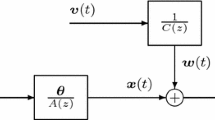Abstract
This paper discusses the parameter estimation problems of nonlinear output error autoregressive systems and presents a data filtering-based multi-innovation stochastic gradient algorithm for improving the parameter estimation accuracy of the stochastic gradient algorithm by combining the multi-innovation identification theory and the data filtering technique. The proposed algorithm is effective and can generate highly accurate parameter estimates compared with the multi-innovation stochastic gradient algorithm. The simulation results confirm this conclusion.







Similar content being viewed by others

References
M.S. Ahmad, O. Kukrer, A. Hocanin, Recursive inverse adaptive filtering algorithm. Digit. Signal Process 21(4), 491–496 (2011)
E.W. Bai, K.S. Chan, Identification of an additive nonlinear system and its applications in generalized Hammerstein models. Automatica 44(2), 430–436 (2008)
J. Chen, Y.X. Ni, Parameter identification methods for an additive nonlinear system. Circuits Syst. Signal Process 33(10), 3053–3064 (2014)
H.B. Chen, W.G. Zhang et al., Data filtering based least squares iterative algorithm for parameter identification of output error autoregressive systems. Inf. Process. Lett. 114(10), 573–578 (2014)
E. De Carvalho, S.M. Omar, D.T.M. Slock, Performance and complexity analysis of blind FIR channel identification algorithms based on deterministic maximum likelihood in SIMO systems. Circuits Syst. Signal Process 32(2), 683–709 (2013)
F. Ding, T. Chen, Performance analysis of multi-innovation gradient type identification methods. Automatica 43(1), 1–14 (2007)
F. Ding, Several multi-innovation identification methods. Digit. Signal Process 20(4), 1027–1039 (2010)
F. Ding, Y. Gu, Performance analysis of the auxiliary model-based stochastic gradient parameter estimation algorithm for state-space systems with one-step state delay. Circuits Syst. Signal Process 32(2), 585–599 (2013)
F. Ding, Hierarchical multi-innovation stochastic gradient algorithm for Hammerstein nonlinear system modeling. Appl. Math. Model. 37(4), 1694–1704 (2013)
J. Ding, C.X. Fan, J.X. Lin, Auxiliary model based parameter estimation for dual-rate output error systems with colored noise. Appl. Math. Model. 37(6), 4051–4058 (2013)
J. Ding, J.X. Lin, Modified subspace identification for periodically non-uniformly sampled systems by using the lifting technique. Circuits Syst. Signal Process 33(5), 1439–1449 (2014)
F. Ding, Y.J. Wang, J. Ding, Recursive least squares parameter identification for systems with colored noise using the filtering technique and the auxiliary model. Digit. Signal Process 37, 100–108 (2015)
L. Han, F. Ding, Multi-innovation stochastic gradient algorithms for multi-input multi-output systems. Digit. Signal Process 19(4), 545–554 (2009)
H.Y. Hu, Y.S. Xiao, R. Ding, Multi-innovation stochastic gradient identification algorithm for Hammerstein controlled autoregressive autoregressive systems based on the key term separation principle and on the model decomposition. J. Appl. Math. Article ID 596141, pp. 1–7(2013). doi:10.1155/2013/596141
Y.B. Hu, Iterative and recursive least squares estimation algorithms for moving average systems. Simul. Model. Pract. Theory 34, 12–19 (2013)
Y.B. Hu, B.L. Liu, Q. Zhou, C. Yang, Recursive extended least squares parameter estimation for Wiener nonlinear systems with moving average noises. Circuits Syst. Signal Process 33(2), 655–664 (2014)
Y. Ji, X.M. Liu, Unified synchronization criteria for hybrid switching-impulsive dynamical networks. Circuits Syst. Signal Process (2015). doi:10.1007/s00034-014-9916-0
Y. Ji, X.M. Liu et al., New criteria for the robust impulsive synchronization of uncertain chaotic delayed nonlinear systems. Nonlinear Dyn. 79(1), 1–9 (2015)
J.H. Li, Parameter estimation for Hammerstein CARARMA systems based on the Newton iteration. Appl. Math. Lett. 26(1), 91–96 (2013)
Y.J. Liu, Y.S. Xiao, X.L. Zhao, Multi-innovation stochastic gradient algorithm for multiple-input single-output systems using the auxiliary model. Appl. Math. Comput. 215(4), 1477–1483 (2009)
Y.J. Liu, L. Yu et al., Multi-innovation extended stochastic gradient algorithm and its performance analysis. Circuits Syst. Signal Process 29(4), 649–667 (2010)
L. Ljung, System Identification: Theory for the User, 2nd edn. (Prentice Hall, Englewood Cliffs, New Jersey, 1999)
L. Ljung, Recursive identification algorithms. Circuits Syst. Signal Process 21(1), 57–68 (2002)
Y.W. Mao, F. Ding, Multi-innovation stochastic gradient identification for Hammerstein controlled autoregressive autoregressive systems based on the filtering technique. Nonlinear Dyn. 79(3), 1745–1755 (2015)
B. Sun, D.Q. Zhu, S.X. Yang, A bio-inspired filtered backstepping cascaded tracking control of 7000 m manned submarine vehicle. IEEE Trans. Ind. Electron. 61(7), 3682–3692 (2014)
J. van Wingerden, M. Verhaegen, Subspace identification of bilinear and LPV systems for open-and closed-loop data. Automatica 45(2), 372–381 (2009)
J. Vörös, Modeling and parameter identification of systems with multi-segment piecewise-linear characteristics. IEEE Trans. Autom. Control 47(1), 184–188 (2002)
J. Vörös, Recursive identification of Hammerstein systems with discontinuous nonlinearities containing dead-zones. IEEE Trans. Autom. Control 48(12), 2203–2206 (2003)
X.R. Wang, B. Huang, T. Chen, Multirate minimum variance control design and control performance assessment: a data-driven subspace approach. IEEE Trans. Control Syst. Technol. 15(1), 65–74 (2007)
D.Q. Wang, Least squares-based recursive and iterative estimation for output error moving average systems using data filtering. IET Control Theory Appl. 5(14), 1648–1657 (2011)
D.Q. Wang, R. Ding, X.Z. Dong, Iterative parameter estimation for a class of multivariable systems based on the hierarchical identification principle and the gradient search. Circuits Syst. Signal Process 31(6), 2167–2177 (2012)
C. Wang, T. Tang, Several gradient-based iterative estimation algorithms for a class of nonlinear systems using the filtering technique. Nonlinear Dyn. 77(3), 769–780 (2014)
W. Wang, T. Tang, Recursive least squares estimation algorithm applied to a class of linear-in-parameters output error moving average systems. Appl. Math. Lett. 29, 36–41 (2014)
G. Zheng, J.P. Barbot, D. Boutat, Identification of the delay parameter for nonlinear time-delay systems with unknown inputs. Automatica 49(6), 1755–1760 (2013)
D.Q. Zhu, H. Huang, S.X. Yang, Dynamic task assignment and path planning of multi-AUV system based on an improved self-organizing map and velocity synthesis method in 3D underwater workspace. IEEE Trans. Cybern. 43(2), 504–514 (2013)
D.Q. Zhu, X. Hua, B. Sun, A neurodynamics control strategy for real-time tracking control of autonomous underwater vehicles. J. Navig. 67(1), 113–127 (2014)
Acknowledgments
This work was supported by the National Natural Science Foundation of China (No. 61273194) and the PAPD of Jiangsu Higher Education Institutions.
Author information
Authors and Affiliations
Corresponding author
Rights and permissions
About this article
Cite this article
Mao, Y., Ding, F. Data Filtering-Based Multi-innovation Stochastic Gradient Algorithm for Nonlinear Output Error Autoregressive Systems. Circuits Syst Signal Process 35, 651–667 (2016). https://doi.org/10.1007/s00034-015-0064-y
Received:
Revised:
Accepted:
Published:
Issue Date:
DOI: https://doi.org/10.1007/s00034-015-0064-y


